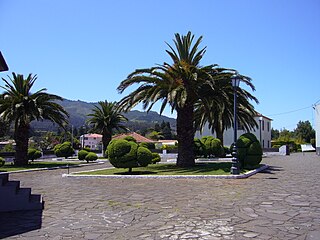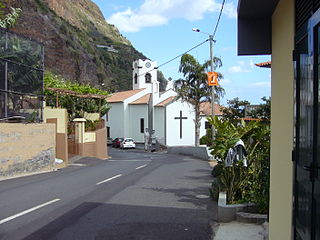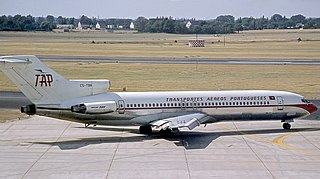
Funchal is the capital, largest city and the municipal seat of Portugal's Autonomous Region of Madeira, bordered by the Atlantic Ocean. The city has a population of 105,795, making it the sixth largest city in Portugal. Because of its high cultural and historical value, Funchal is one of Portugal's main tourist attractions; it is also popular as a destination for New Year's Eve, and it is the leading Portuguese port on cruise liner dockings.

Água de Pena is a civil parish in the municipality of Machico on the south-east coast of the Portuguese island of Madeira. The population in 2011 was 2,434, in an area of 5.15 km².

Santo António da Serra is a civil parish in the interior of the municipality of Machico, on the island of Madeira. The parish is adjacent to another parish in the neighbouring municipality of Santa Cruz to the south, which is also named Santo António da Serra. The population in 2011 was 1,617, in an area of 8.62 km2.

Madalena do Mar is a civil parish in the municipality of Ponta do Sol in the Portuguese archipelago of Madeira. The population in 2011 was 516, in an area of 2.07 km2.

Santa Maria Maior is a civil parish in the eastern part of the municipality of Funchal on the island of Madeira. The population in 2011 was 13,352, in an area of 4.86 km2.
Santo António is a civil parish in the northwestern part of the municipality of Funchal on the island of Madeira. It is located about 3 km northwest of central Funchal. The most populous civil parish in the archipelago, it extends into the mountainous interior of the island. The population in 2011 was 27,383, in an area of 22.16 km2.

São Gonçalo is a freguesia parish in the municipality of Funchal, located near the south coast of the island of Madeira, in Portugal.

Caniço is a parish in the municipality of Santa Cruz in the Madeira Islands. It was elevated to city status in 2005. The population in 2011 was 23,368, in an area of 11.99 km2. Caniço is connected to the urban sprawl of Funchal and is larger than the seat of the municipality. It is located 6 km east of Funchal.

João Gonçalves Zarco was a Portuguese explorer who established settlements and recognition of the Madeira Islands, and was appointed first captain of Funchal by Henry the Navigator.

The history of Madeira begins with the discovery of the islands by Portugal in 1419. There is no record of anyone living on the islands at that time. Portugal began populating the island in 1420.

Madeira Airport, informally Funchal Airport, formerly Santa Catarina Airport and officially Cristiano Ronaldo International Airport, is an international airport in the civil parish of Santa Cruz in the Portuguese archipelago and autonomous region of Madeira. The airport is located 13.2 km (8.2 mi) east-northeast of the regional capital, Funchal, after which it is sometimes informally named. It mostly hosts flights to European metropolitan destinations due to Madeira's importance as a leisure destination, and is pivotal in the movement of cargo in and out of the archipelago of Madeira. It is the fourth-busiest airport in Portugal. The airport is named after Madeiran native Cristiano Ronaldo, considered one of the greatest footballers of all time. During its renaming ceremony in 2017, the airport drew media notoriety for an infamous bust of Ronaldo unveiled at the ceremony, now replaced.
Catarina Fagundes is a Portuguese sailor. She competed in the Mistral Windsurf Class at the 1996 Summer Olympics in Atlanta, Georgia, and achieved the 21st position. She was the first Portuguese female athlete to enter an Olympic event in a sailing class.

The Roman Catholic Diocese of Funchal is a Latin Church ecclesiastical territory or patriarchal archdiocese of the Catholic Church in Portugal. It was originally created on 12 June 1514 by the papal bull Pro excellenti præeminentia from Pope Leo X, following the elevation of Funchal from a village to the status of city, by King Manuel I of Portugal. The diocese was a suffragan of the Archdiocese of Lisbon.

TAP Flight 425 was a regular flight from Brussels, Belgium, to Santa Catarina Airport, Portugal, with an intermediate scheduled stop in Lisbon. On 19 November 1977, the Boeing 727 operating the service overran the airport's runway before crashing onto the nearby beach and exploding, killing 131 of the 164 people on board.

The Madeira islands and Funchal have an extensive public transportation system. Travel between the two main islands is by plane or by ferries, the latter also allowing for the transportation of vehicles. Visiting the interior of the islands is now easy, due to major road developments, known as the Vias rápidas, on the islands during Portugal's economic boom.

During World War II, the British government evacuated the majority of the civilian population of Gibraltar in 1940 in order to reinforce the territory with more military personnel, though civilians with essential jobs were permitted to stay. The civilian evacuees were sent to numerous locations, including London, Madeira and Jamaica; some spent up to a decade away from Gibraltar, but the majority returned in 1943 after the Allied invasion of Sicily. The evacuation reinforced the British national identity of the Gibraltarians via their participation in the Allied war effort.

The history of the Jews in Madeira spans the entire length of the history of Madeira itself. The history of Madeira begins with the discovery of the islands by Portugal in 1419. Madeira is presently officially the Autonomous Region of Madeira, and is one of the two autonomous regions of Portugal. It is an archipelago situated in the north Atlantic Ocean, southwest of Portugal. According to the 2021 census, it had a total population of 250,744. The capital of Madeira is Funchal, which is located on the main island's south coast.

Mary Jane WilsonDamTE, also known as Sister Maria of Saint Francis, was an Englishwoman born in India who founded the Congregation of the Franciscan Sisters of Our Lady of Victories. Wilson was declared venerable by Pope Francis.

The Fort of São Tiago is a historic military fort located in the historical centre of Funchal, Madeira. Constructed in the early 17th century, the fort was built to protect the island against pirate attacks and foreign invasions. The fort is notable for its prominent yellow walls, which contrast with the surrounding architecture, and its strategic position overlooking the Atlantic Ocean. Today, Fort of São Tiago serves as both a cultural landmark and a popular tourist attraction, offering panoramic views of the sea and the city of Funchal.























